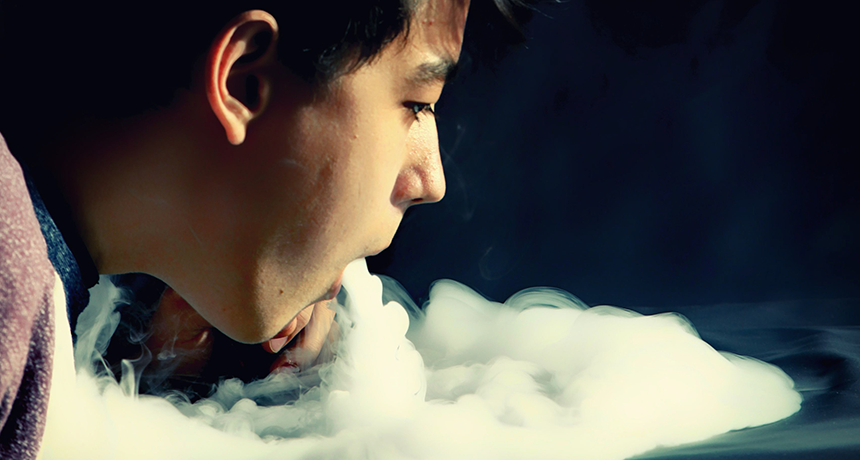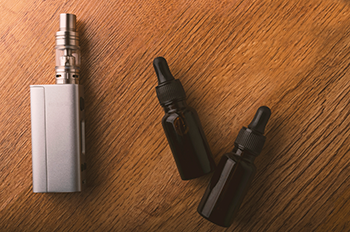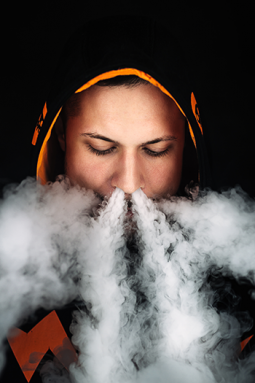Vape tricks could increase health risks, experts warn
Stunts could expose teens to higher levels of harmful chemicals, scientists worry

Tricks using the vapor clouds from e-cigarettes and other vaping devices are popular among some teens. Researchers now worry these behaviors could boost health risks. Here, a vaper creates a “waterfall.”
Aleksandr Pogudin/iStockphoto
Waterfall. Cheerios. Cloud chasing. These are names for shapes or patterns that people can make when exhaling vapor from an e-cigarette or other vaping device. A new study of teen vapers shows that more than three in every four had tried such tricks. While they might be fun, researchers worry that such stunts could lead to increased health risks for teens.
“The high number of adolescent e-cigarette users that have tried vape tricks tells us it could be an important reason why some teens vape,” says Adam Leventhal. He studies addiction at the University of Southern California in Los Angeles. He was not part of the new research.
Earlier studies have shown that some teens vape because they think it looks cool. Others want to try the fruit- and candy-flavored e-liquids used to make vape clouds. Vape tricks may be another factor, says Jessica Pepper.
Pepper wants to know what motivates teens to vape. She works for a research institute called RTI International. It’s located in Research Triangle Park, N.C. As a social scientist, she studies how different groups of people behave. Her focus: teen vapers.
Pepper watched online videos of e-cigarette users performing the tricks. Some blew tiny vapor rings (cheerios). Others spewed out big, thick billows of vapor (cloud chasing). “I could see why teens might be interested. Some of the tricks were fascinating,” Pepper admits.

Her team created an online survey to gauge how common these tricks are among teen vapers. She also wanted to see whether these stunts are more appealing to certain teens.
Some of their survey questions asked about vape tricks and how often teens vaped. Others asked how safe — or harmful — teens thought vaping was. Still more questions focused on what type of vaping devices teens use.
Pepper advertised the survey on Instagram and Facebook. More than 1,700 people took part. All were between the ages of 15 and 17. Each reported vaping at least once in the last month.
More than three in every four of the teens reported having tried vape tricks. Almost as many said they had watched vape tricks online. About 84 percent said they had watched another person do these tricks.
Teens who reported vaping every day were more likely to have tried vape tricks than teens who vaped less frequently. Teens who said vaping was common among their peers or who reported frequently seeing or sharing social media posts on vaping also were more likely to do vape tricks. Teens who said they were concerned about health risks of vaping were less likely to have tried the tricks.
These data were collected from a single point in time. That means the researchers don’t know which interest came first: vaping or being impressed by vape tricks. So the researchers can’t say whether vape tricks encourage nonvapers to pick up the habit. Many scientists and policy makers would like to find out if this might be true.
Health concerns
Pepper and her colleagues also asked the teens about their use of electronic vaporizers. These modifiable devices, or mods, often have refillable tanks and other special features. Teens who used mods were more likely to have tried vape tricks. That’s important, says Leventhal, because mods put out more power than smaller “cigalikes” or vape pens. More power means a bigger, thicker vapor cloud. And that matters because of what’s in it.

The vapor cloud from an e-cigarette is a fog of tiny particles suspended in air. It is also called an aerosol. E-cig aerosols may expose users to potentially harmful chemicals, such as formaldehyde (For-MAAL-duh-hyde). This colorless liquid or gas can irritate the skin, eyes or throat. High exposures to formaldehyde can pose a risk of cancer.
Some vape tricks involve breathing aerosols deep into the lungs and then blowing them out of the ears, eyes or nose. That concerns Irfan Rahman. He’s a toxicologist at the University of Rochester in New York. Rahman studies the effects of chemicals in vapor clouds on cells and tissues of the body.
A thin, protective lining coats the inside of the nose, lungs and mouth. It acts like a shield to keep dust and other foreign particles from hurting these tissues, explains Rahman. His research has shown that aerosols from vaping can damage this protective shield.
Small changes over time could lead to inflammation, he says. Inflammation is one way that cells respond to injury. Excessive inflammation can up someone’s risk of certain diseases. “If vape tricks expose these sensitive tissues to more aerosols, we would suspect more harm from these behaviors,” concludes Rahman.
Scientists are still learning about health risks posed by vaping. Plenty of questions remain. But what is clear, they warn, is that vaping is not harmless.
“The aerosols in e-cigarettes can contain harmful chemicals,” says Leventhal. Keep that in mind, he says, “if you are thinking about using e-cigarettes to do vape tricks or you already like to do vape tricks.” It would be far better, he advises, to “choose ways to have fun that don’t involve exposing your body to these substances.”







